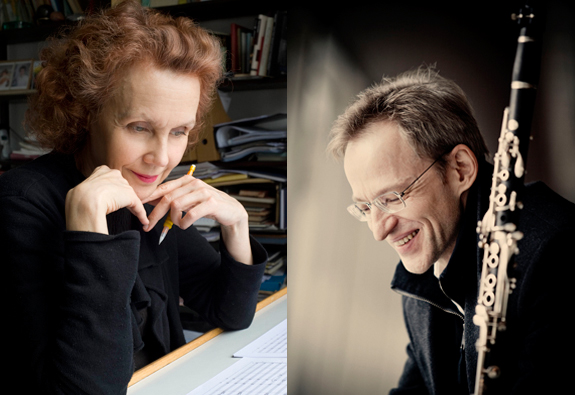
The Fantastic Finns reveal the voice of “The Unicorn”
By Sebastian Spreng, Visual Artist and Classical Music Writer
With the U.S. premiere of Kaija Saariaho’s Clarinet Concerto, the New World Symphony ends an ascendant year on a high note. The evening demonstrated once more the indisputable, exemplary and healthy state of music in Finland, a true breeding ground for musical talent. The concert was conducted by Susanna Mälkki and featured clarinetist Kari Kriikku, to whom it was dedicated. The renowned Finn soloist was involved in the commissioning and premiere of concerts by Kimmo Hakola, Jouni Kaipainen and Magnus Lindberg, and here flouted all convention with a performance as bold and fascinating as the concert itself.
Composer Kaija Saariaho and clarinetist Kari Kriikku
Inspired by The Lady and the Unicorn, the magnificent set of medieval tapestries on display at the Musée de Cluny in Paris, where Saariaho lives, it comprises six movements, one per tapestry, and the physical sense each represents. The last one bears the inscription A mon seul désir and because of its ambiguity also titles the work with a mysterious anagram: “D’OM LE VRAI SENSE.”
Saariaho not only succeeded in depicting each sense – hearing, sight, smell, taste, touch and an intimate, undefined sixth – but also wove a mood of enchantment that virtually mesmerized the audience. She is clearly a worthy successor of the illustrious Nordic tradition, from Sibelius to Carl Nielsen, Einojuhani Rautavaara, Aulis Sallinen and Einar Englund.
A contemporary work, accessible and comforting, the Concert for Clarinet leaves behind a feeling of overpowering mystery, a mystery created by the orchestra, which acts as a framing device – an impenetrable, luxuriant forest of deep greens that the composer appropriately described as “orchestral breathing” – a dark forest where a single light flickers: the elusive unicorn embodied by the clarinet.
Because of its extremely wide, almost impossible, range, the “voice” of the legendary creature presented a challenge to the virtuosity of the clarinetist, who also strolled around the auditorium, confronting, observing, and having fun with both audience and orchestra. Neither clarinet, nor bird, nor whale nor human, but all in one, like a mythical animal the amazing Kriikku was ideal in both his musicianship and physical expression. With trills, embellishments, modulations and tremolos, like a latter-day amalgam of Krishna and the Pied Piper of Hamelin, Kiikku drew away the members of the orchestra, one by one, in a coordinated staging that included slides of the tapestries projected on the walls. It was a dreamlike experience, with no discordant elements, that echoed serenely in memory and whetted the appetite for more Saariaho, the most famous of contemporary female composers along with veteran Sofia Gubaidulina.
In keeping with the name “Parisian Tapestries,” the program concluded with Berlioz’s Symphonie Fantastique, a crowd-pleasing choice that turned out to be perfectly compatible, rounding out a fantastic tapestry. Once more, Susanna Mälkki was outstanding. Elegant and expressive, she established magnificent rapport with the orchestra, which responded with impeccable precision. Clear and powerful, her Berlioz evinced an “analytical” approach that nevertheless respected the distinguishing marks of each movement in a piece imbued in overpowering romanticism. Fluid and refined, the witches’ Sabbath and the march to the scaffold topped off a concert in which fantasy worlds collided with reality. It was a fantastical experiment in which the gifted Finn’s wand succeeded in working magic.
Recent Content
-
Artsarticle ·
-
Artsarticle ·
-
Artsarticle ·
